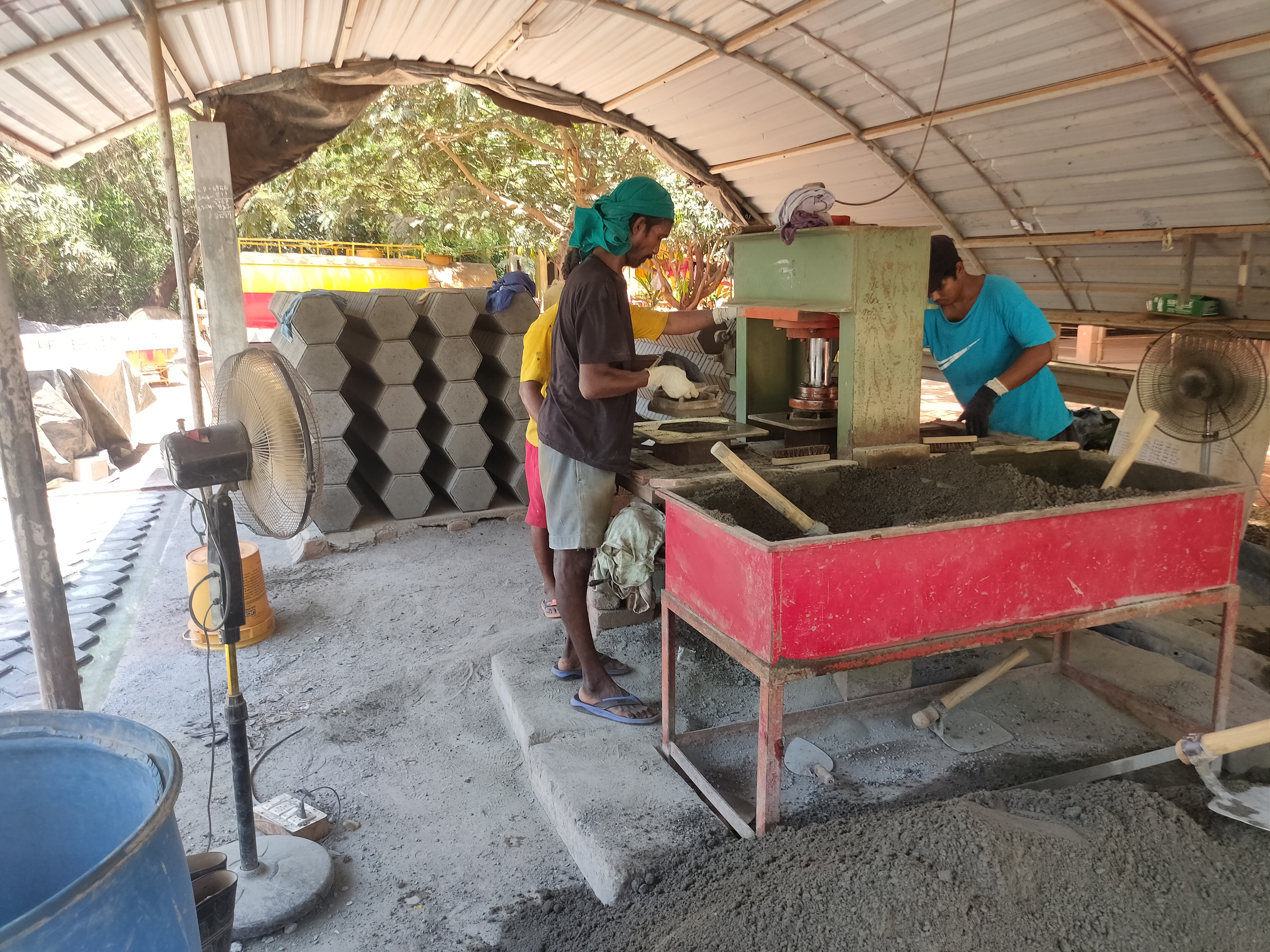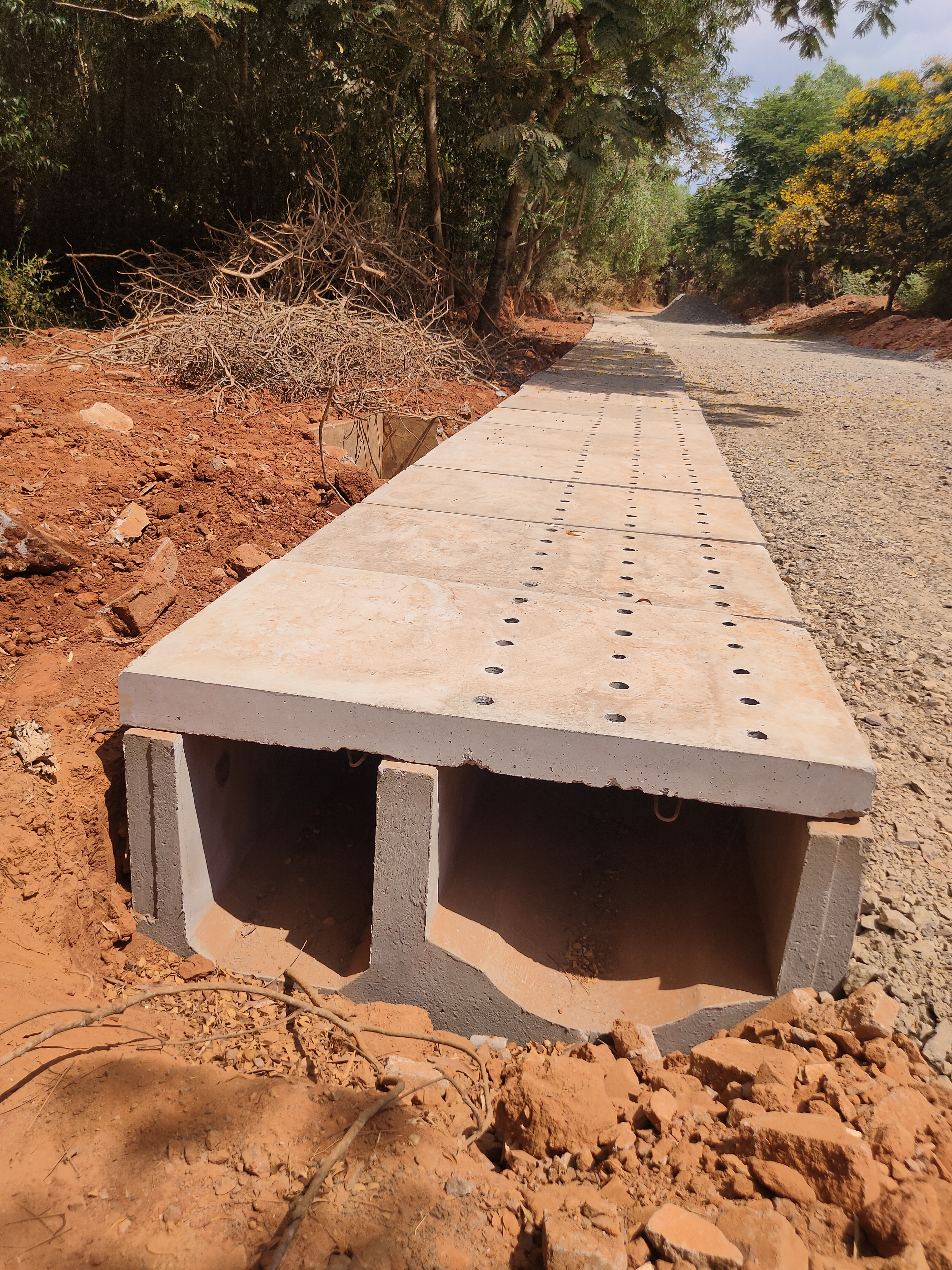New Hope For The Roads
Auroville Today Headline Article, May 2024 Issue
AVI USA is collaborating with Auroville Today to bring you the latest Auroville news for the next few months. AVI USA readers will have first access to the unlocked Auroville Today headline articles through the summer through our collaboration with Auroville’s premiere news outlet! You will find the articles in monthly entries on our AVI USA Blog. Please consider supporting and subscribing to Auroville Today!

Dr. Jayanti Ravi, the Secretary of the Auroville Foundation, recently has looked into the possibility to build the remaining section of the Crown Road with all components being manufactured in Auroville and using Auroville resources for its construction. Michael Bonke and his team have offered to organise this and even take up organising the finances for the project. Michael explains the new development, his plans for this and other roads and his hope that this new development will help in bringing people in Auroville together.
Auroville Today: Michael, can you tell us what has happened?
Michael: 2,552 metres of the Crown (phase 1) has been done by Central Public Works Department (CPWD). 155 metres (phase 2) will still be done by the CPWD. 170 metres are connectivity portions like culverts etc. This also is already under contract with the CPWD. 984 metres (phase 3) has been given to us now. In addition to this there are 498 metres where the land still has to be purchased. This part of the Crown also is planned to be done by us. So in total we intend to take care of 1.4 km of the crown.
Till now the Crown has been built with big concrete slabs which are manufactured in Bangalore and are transported all the way from there by lorries to Auroville. If we make the road in-house, meaning in Auroville and by Aurovilians or Auroville units, we can make it cheaper, faster and I think even better. Auroville with its Road Service and a good number of engineers is well equipped to do the job.
What are the major changes?
Michael: The biggest change is that we use paver blocks instead of the large concrete slabs. Another change is that we will do away with the concept of a water duct at the side of the road to collect run-off water. The original idea was that the water so collected would flow into the Darkali pond, be purified, and from there be pumped into the Matrimandir Lake. For this reason the Crown has been constructed at the same level, at certain places higher than the plinth level of the buildings that border it. As there is a height-difference of 13 meters from the East of the Crown to the West, this concept has to be discarded. We will continue having concrete ducts along the road, but only for infrastructure such as pipes and cables. The ducts along the built stretch of the Crown will be modified – we’ll close the holes – and also use them for this purpose. A major change is therefore that we will build the Crown parallel to the contours of the area. Also our concept of the right-of-way is different. We will not cut all the trees which are within the 24 meter wide right-of-way. Only trees which are on the carriage (7 meter width) or on the place for the ducts will have to be removed.
You’ll use the same type of pavers that were used for the old road?
Michael: No. Our pavers have to match the standards for traffic-roads according to the rules of the CPWD and must have the strength of M-50. The old Auroville pavers have a load-bearing capacity of M-40. Secondly, the old pavers had a height of only 80 mm. The new ones will have a height of 120 mm. Mr. Goel, the former head of the Central Public Works Department who is at present the Chief Advisor to the Auroville Foundation, is helping us to match the standards prescribed for roads.
The work has been allocated to you and your team. But you are also involved in many other activities. How do you manage that?
Michael: This focus on me as an individual is a bit misleading. There is a team of people who have agreed to do the work. Auroville has many experts in the construction sector. The Road Service has a lot of experience in making pavers, there are specialists in concrete casting, there are free-lance engineers with experience in paver work. We also have urban designers in Auroville, landscapers, architects like the Dreamweavers team etc. My role will be the coordination of the team (especially in the beginning), the coordination of the finances and the interaction with the Auroville Foundation Office and the TDC. Once the project is on its way, my role in the matter hopefully will be much less active.

The Crown Road is planned to go over lands that do not belong to Auroville. Will you be involved in land purchase negotiations?
Michael: This is not yet clear. Land-negotiations tend to be difficult, but private parties have sometimes more flexibility in land-purchase and are therefore more successful. Aditi Diamonds Pvt. Ltd. and Varuna Pvt. Ltd. purchased nice pieces of lands outside of Auroville a number of years ago. We could maybe exchange those pieces against land on the crown, if required.
The tree-cutting in connection with the road construction in Auroville has caused a lot of resentment. You mention that no more trees will be cut.
Michael: In principle everybody here is happy about the beautiful forest areas we have created in Auroville. And equally, everybody is aware that you cannot build a city without cutting some of the trees. But the politicisation of trees as a weapon against construction projects on one side and on the other side the appetite for an over-designed “right of way” for infrastructure has led to a situation where mistakes have been made unnecessarily. We would be well advised to de-politicise the tree-issue, which then could lead to a situation that trees will not be cut anymore prophylactically, when one has the chance to do so.

Who will make the paver blocks?
Michael: The Auroville Road Service. They have two machines, and they have already made the first batch according to the new formula. Those pavers are being cured for 28 days, after which they will be sent to IIT in Chennai or PEC in Pondicherry to be tested. If we have reached the required M50 standard, then we can start. We have calculated that with the two machines and people working in two eight-hour shifts, we can produce 3,000 pavers a day. The first stretch of the Crown Road we’ll build is 984 meters long. That will take us about three months, not counting the underlay work. The Auroville Transport Service has agreed that we can use its space for curing and storing all those paver blocks.

And the duct channels?
Michael: The duct channels will be made by Eric. We have found a place for him to make the ducts in the Industrial Zone on a piece of land which we are preparing for constructing a Line of Force.
Who pays for all this?
Michael: Although the Secretary has offered several times to use Government funds for this project, we prefer to use private funds or donations from our circle of Auroville-donors.
Is there a written agreement with the Auroville Foundation?
Michael: There are of course minutes of the meetings, for example TDC meetings, which reflect our agreements. But otherwise nobody till now has demanded any agreement in writing. Neither has the Road Service asked us for a written agreement, nor any of the participating Aurovilians, nor anybody else. This is one of the nice traits of the project, that we all are convinced of its success and that we do this in a team-spirit.
You mentioned the involvement of the Dreamweavers.
Michael: Yes, we are all very open to the idea that they participate in this work. We also tried to find a consultant and we contacted Professor Rahul Mehrotra, a professor of Urban Design and Planning at Harvard University’s Graduate School of Design. He had promised to visit Auroville in March, but then did not come because of having Covid. We are waiting for the urban design architects we contacted to come back to us.
Do you expect opposition to your team manifesting this second stretch of the Crown as specified by you?
Michael: I hope not, but given my experience in Auroville, it is definitely possible. We want to start building this road as soon as possible, and nobody would like to get entangled in endless discussions with members of this or that working group who may have, or think they have, the authority to ‘approve’ the project. Till now most of the people who are on board have not put up any preconditions for community participation, probably because we all know that this development is in the positive interest of the whole of Auroville. If all of us can show the willingness to cooperate, this project might be a help to bridge the divisions which are now harming the community so much.
In conversation with Alan and Carel
